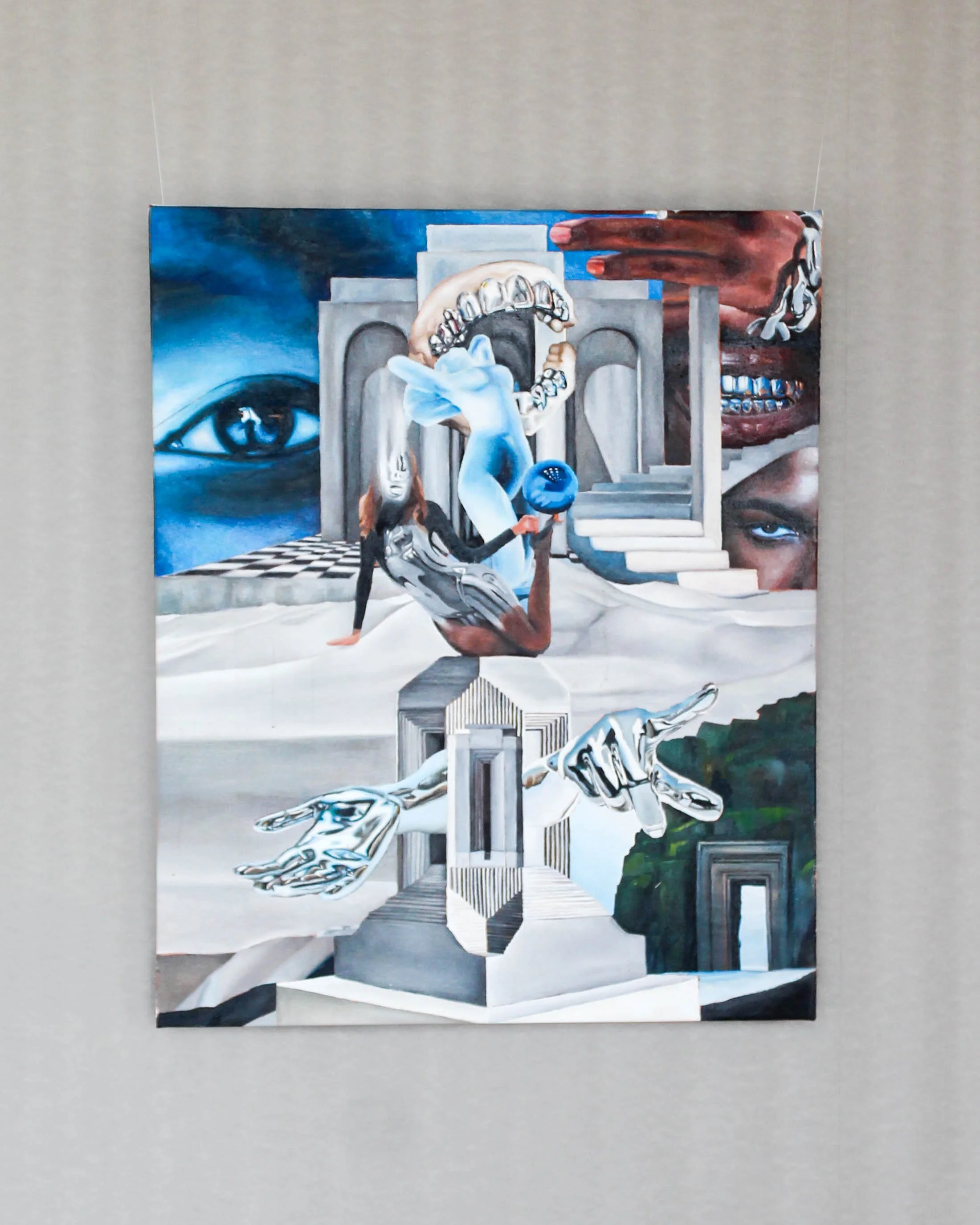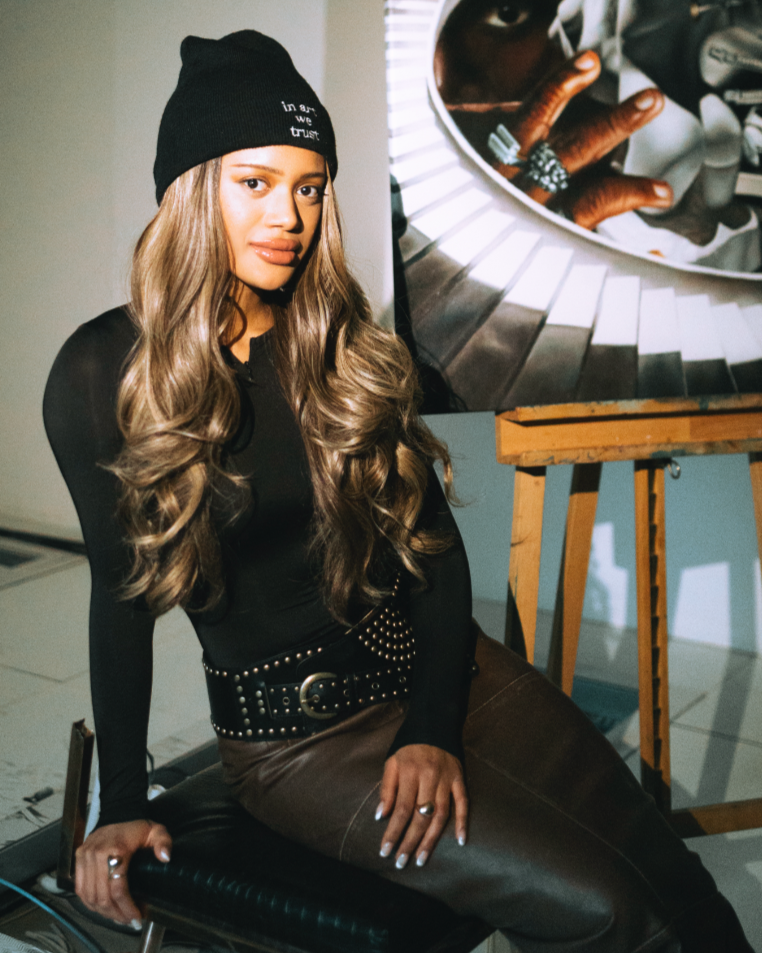Helen Ifeagwu Paints Culture en Surreal
Where Paul Manship meets Kendrick Lamar, Helen Ifeagwu emerges. The artist investigates cultural authorship, transnational identity, and Afrofuturist visions in oil.
by Josiah David Jones
October 16, 2025
I’d like to introduce you to Helen Ifeagwu. A self-taught, Austrian-Nigerian oil painter based in Vienna. She investigates the world through a lens informed by her studies in journalism, translated into works shaped by disciplines of modern masters.
The results: a dreamlike, Afrofuturist, chrome-drippin’, culture-coded collage of her inquisitions, observations, and evidence of how she experiences the world. “Clones”, for instance; figures turning to chrome, morphing into mirrors that double as machines; eyes, cameras, and screens sprouting from their bodies like extra organs. Portraiture spliced with elemental mutations, realism toggling into hallucination. The pictures hold that fine balance of the surreal. Numerous visual anchors cohering into a complete image, an original world offered through Helen’s exploration of life, culture, community, and art.
Inside the studio the vocabulary is crisp. “The female body is a central symbol.” Masculine hands appear as counter-force, introducing “dynamic tension and balance.” Chrome becomes a philosophy—“a visual language” for the meeting of humanity and machine, “the organic and the synthetic.” Around them, elementals anchor the future to something older.
The word “aligned” returned as we discussed two climates: the studio practice solace and the public demand of the online audience. She names the weather plainly: there’s “a tension between creating freely and creating strategically,” especially when the algorithm “favors certain trends or formats” that don’t match what she actually wants to say. Keeping the balance is the a major part of the work.
“[For me] painting transforms into more of a medium for communication rather than just a focus on aesthetics.”
Growth in practice, being towards stronger purpose rather than a steadier hand. She tracks evolution “through the themes I explore and what I want to express,” letting intention mature so message leads technique.
Double Slit, at black in every color.
Helen’s pictures read like reporting done in another language. “My experience in journalism strongly influences how I tell stories through my art.” Before paint touches canvas, there’s groundwork: “I spend a lot of time researching symbols, histories, and cultural meanings that can add depth to the work… this preparation helps me create imagery that holds significance beyond the surface, giving the piece a foundation rooted in knowledge and intention.”
J: “Coming from a journalism background, how does your approach to visual storytelling differ from your approach to written narrative?”
“Unlike writing, where stories unfold through words and clear narratives, visual storytelling works through suggestion and layers…I use symbolism as a tool to communicate ideas and emotions indirectly, allowing viewers to connect with the work in their own way.”
Where writing advances in sentences, her images work by suggestion.
“This openness is something that helps me invite personal interpretations rather than delivering a fixed message.”
J: “Is there a research or observational practice that underpins your process before you begin a piece?”
“Research and observation are integral to my process… I’m always immersing myself in ideas that can stretch the conceptual framework of the work by reading theories, exploring scientific concepts, or absorbing other forms of media…music plays a big role too… it shapes the mood and rhythm of my painting process, almost like a subconscious collaborator.”
“I also spend time revisiting artists and works that inspire me, not to replicate but to understand the energy and symbolism they hold.”
Two recent touchstones arrived by chance: “‘The Furniture of Time’ by Yves Tanguy and ‘Moods of Time’ by Paul Manship have been recent favourites… It’s not just for their surrealist or sculptural qualities, but for the way they personify time as a tangible, almost architectural presence.”
Between Worlds: Cultural Authorship & Dual Belonging
Look closely and elements of her language become legible. From Vienna: Klimt’s pattern and symbolism; Ernst Fuchs’s “magical imagery.” Exploration of Nigerian roots: “vibrant cultural narratives” that carry weight and story.
“[It’s] an ongoing conversation between cultures,” a push–pull of “tension and harmony” that keeps the vocabulary alive. An early marker is Royalty: “a green Afro-centric figure cloaked in silver leaf,” drawing from Gustav Klimt while portraying a human figure inspired by a Nigerian oba.
J- “As an artist with a transnational background, do you consider the concept of cultural authorship in your work?”
Yes, cultural authorship is something I’m constantly aware of. My transnational background means my influences aren’t contained within one place, but I never treat them as mine to claim. I see them as things I’ve encountered, lived with, and reinterpreted through my own lens.”
Homage is specific:
“When I pay homage to hip hop culture… I’m not borrowing it as an aesthetic trend. I’m recognising its role as a cultural force that shaped so much of my own sensibility growing up… Those symbols are in my work with acknowledgement, and the understanding that they carry history, resistance, and community within them. My role feels more like a bridge… bringing elements into dialogue, layering them with my own symbols and experiences, and allowing something new to emerge from that exchange.”
J: “Do you find elements of yourself negotiating identity and belonging through your work? Maybe even asserting it?”
“Yes, absolutely… for me, it’s frequently a way of negotiating identity and belonging, sometimes even on a subconscious level. Somehow sometimes the meaning becomes clearer only after the piece is finished.” Synthia in the Waiting Room emerged “during a major transition,” moving continents and feeling “the tension of being between two realities.” Only later did the picture reveal itself: “I realized it was an allegory for my own experience of transformation. The figure of Synthia, an AI, came to symbolize this emerging new self and also reflected a feeling of relinquishing control…” In that sense, “the painting became an unintentional self-portrait,” a record of “internal conflict and evolution.”
J: “As a biracial individual myself, I find personal expressions a blend of cultural and societal experiences, often navigating expectations, even just from a regional identity. Do you resonate with the notion of dual belonging?
“I really do resonate with the idea of dual belonging… Being biracial means living between worlds and it’s both grounding and challenging to feel connected to a place while also seeing it from a distance, almost like an observer of your own identity.”
It’s why the observer motif returns: “This is why I often play with the idea of reality and incorporate the observer’s eye symbol in my paintings to reflect consciousness, as if I am taking a bird’s-eye view of my experience.”
Responsibility, Support, Horizon
If you’re wondering what to expect next, Helen is clear about the conversations she wants to set in motion: “I think next I want my work to spark conversations about layered identity, cultural hybridity, and the way memory and futurism can coexist in one visual space.”
She’s attentive to how meaning travels: “I’m interested in how audiences read symbols differently depending on their own histories and shared perspectives. I hope my paintings invite people to question where those interpretations come from and why they are perpetuated. More than anything, I want the work to feel like an open conversation between cultures, between past and future, and between the seen and the imagined.”
“Support to me is about curiosity and believing in the work as it evolves.”
On support—institutions, collectors, community—she doesn’t speak in abstractions: “Perhaps trust in my vision before it’s fully formed. From institutions, that means opportunities to develop long-term projects rather than one-off appearances. From collectors, it’s recognising that investing in the process is as important as acquiring the finished work. And from my community, it’s the encouragement to take risks and explore as well as continued shared dialog about art coming from our community.”
As for where the work should meet its public next: “I’m really excited about reaching audiences who appreciate art that blends cultural narratives and explores identity in nuanced ways. I want to connect more deeply with communities that value storytelling beyond just the visual and people who are curious about the symbols, themes, and layered meanings in my work.”
Her map is wide by design: “Expanding into international art fairs and collaborative exhibitions feels like a natural next step because those spaces foster rich dialogues and diverse perspectives. I would love to be more present in the U.S., as I am deeply inspired by a lot of the art from there. I’m also eager to engage more with online audiences who are passionate about contemporary art but want something thoughtful and meaningful, not just something that trends.”
Metal Genesis
And the charge stays consistent: “Creating work that sparks conversation and invites viewers to reflect on the intersections of culture, technology, and humanity is where I see the most exciting opportunities, because that’s what I think society needs to be focusing on. Ultimately, I want my art to build bridges, reaching people across different backgrounds and inspiring connections that go beyond borders.”
We’re proudly presenting Helen’s works through black in every color. for the first time in the U.S. Our goal, create dialogue, connection and appreciation for an artist dedicated to her practice and continue the ongoing conversation we’re committed to building with her. The aim is simple: put rigorous, resonant work in front of a community that will look longer, ask more questions, and carry the experience forward.
Helen’s newest work, “Double Slit” can be found exhibiting at black in every color. at the Andaz West Hollywood through December 31st.
Helen Ifeagwu’s paintings emerge from a space between realism and imagination, drawing on her dual heritage and a deep curiosity about the relationship between humans, nature, and technology. Born to Austrian and Nigerian parents and based in Vienna, her practice is shaped by a background in journalism and visual art, with studies at City, University of London and the Cambridge School of Visual and Performing Arts. Guided by an Afrofuturist lens, Ifeagwu’s work blends symbolic detail with surreal atmospheres—inviting viewers to consider identity as something both grounded and speculative, personal and universal.
IG: @hellytheartist








